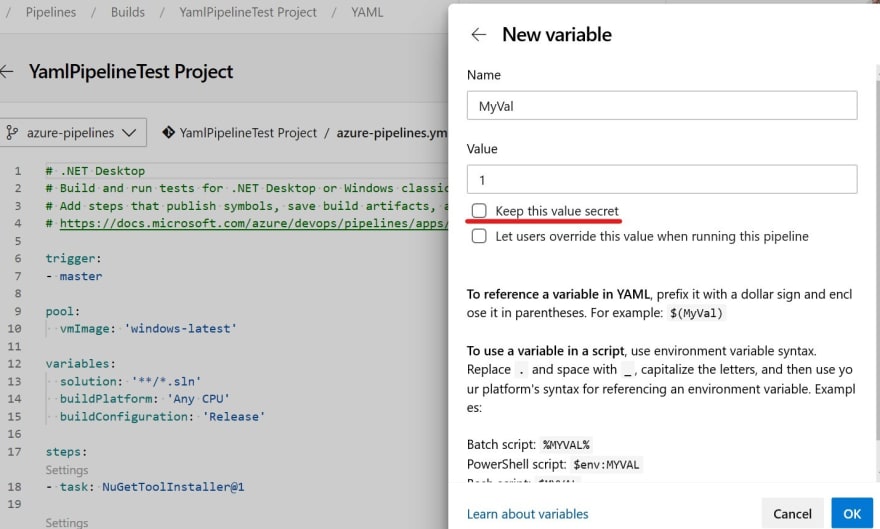I use Azure DevOps for long time, and I always use GUI when crafting Build Pipeline so far, though I knew Azure DevOps supports YAML and its benefits.
So this time, I tried YAML instead of GUI and I learnt many things. In this article, I talk about "variables".
Variables in GUI
Let's start from GUI. There is a place to store variables for pipeline scope.

Use $(xxx) format to reference it.
Variable in YAML
First of all, I can reference variable same as GUI. In addition, I can directly write parameter in YAML.
variables:
myval: 1
I can also use all the out-of-box variables as well as my own defined variable groups.
Secret value
As YAML is simply a text file, I shouldn't store any secret. I can use "Variable" feature of YAML editor to store both non-secure and secure variables.
But where this variables are stored?
It's easy to store, but I needed to know the trick to use it, as I couldn't simply reference it. It was obvious if I read the document carefully, but I didn't :D. Basically, I need to map the variable to environment variable to reference it.
steps:
- powershell: |
# Using an input-macro:
Write-Host "This works: $(mySecret)"
# Using the env var directly:
Write-Host "This does not work: $env:MYSECRET"
# Using the mapped env var:
Write-Host "This works: $env:MY_MAPPED_ENV_VAR" # Recommended
env:
MY_MAPPED_ENV_VAR: $(mySecret)
Variable Template
The reason why I use variable group is to grouping variables. Then, I realized that YAML also has similar feature, called variable template.
I just need to create YAML file contains variables I want to group.
# File: vars.yml
variables:
favoriteVeggie: 'brussels sprouts'
Then reference it in another YAML.
variables:
- template: vars.yml # Template reference
steps:
- script: echo My favorite vegetable is ${{ variables.favoriteVeggie }}.
Templates are not only for variables but for more powerful stuff. I will find sometime later to talk about what I found in template if I can.
Service Connection as variable
One of the variable I couldn't figure out at first was service connection.
I tried to build and push docker container to Azure Container Registry and refer to the documentation below.
Build and push to Azure Container Registry
Inside the article, there is YAML example.
- stage: Build
displayName: Build and push stage
jobs:
- job: Build
displayName: Build job
pool:
vmImage: $(vmImageName)
steps:
- task: Docker@2
displayName: Build and push an image to container registry
inputs:
command: buildAndPush
repository: $(imageRepository)
dockerfile: $(dockerfilePath)
containerRegistry: $(dockerRegistryServiceConnection)
tags: |
$(tag)
I couldn't find where this dockerRegistryServiceConnection variable comes in, and I later realized I simply pass the service connection name as parameter.
When I use template, it gave me GUID but I actually can simply use string name of the service connection. In the example below, I set variable in YAML and use it.
trigger:
- master
pool:
vmImage: 'ubuntu-latest'
variables:
acrConnection: 'MyAcrServiceConnection'
imageName: 'sample-image'
steps:
- task: Docker@2
displayName: BuildAndPushImageToACR
inputs:
repository: $(imageName)
command: 'buildAndPush'
containerRegistry: $(acrConnection)
Dockerfile: '**/Dockerfile'
tags: $(Build.BuildId)
Summary
In this article, I talk about variables in YAML. I am glad to find that it can use all the variables from Library and pipeline scoped ones as GUI does. In addition I can write it to YAML so it's easy to migrate to other DevOps environment.













Top comments (0)